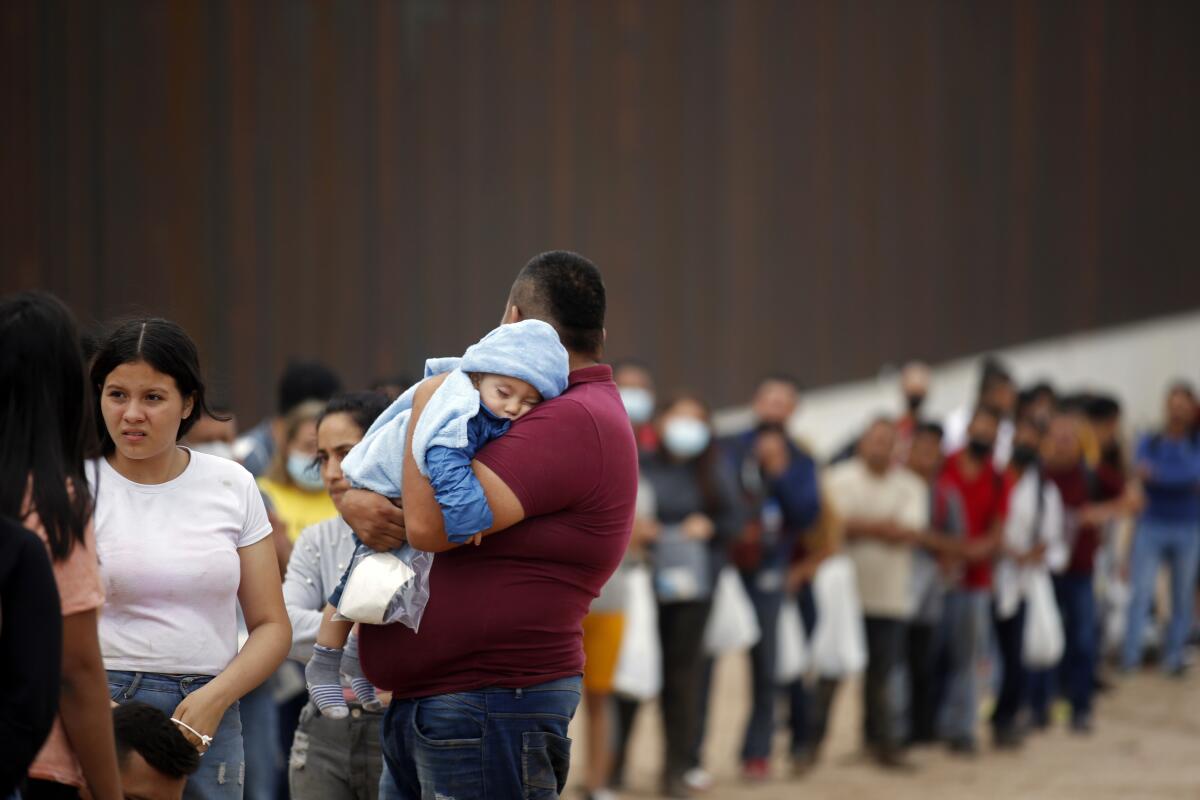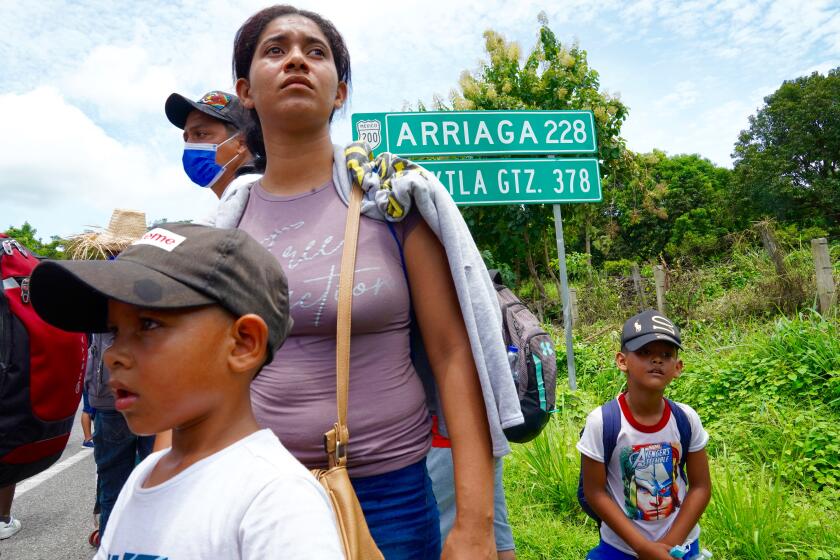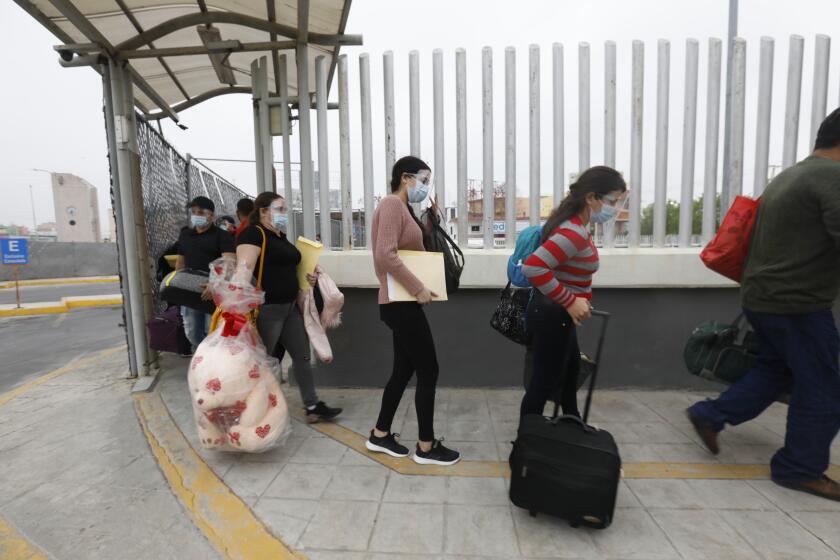Federal judge extends the blocking of Biden administrationâs plans to lift Title 42

WASHINGTON â A Louisiana judge has extended his temporary block of the Biden administrationâs plan to lift pandemic-related border restrictions on Monday.
In a ruling issued Friday, U.S. District Judge Robert Summerhays in Lafayette wrote that lawyers for 24 plaintiff states had established that a âsignificant threat of injuryâ would arise if Title 42, a 1944 federal public health statute invoked by the Trump administration at the start of the pandemic, were to be lifted. He cited federal government figures predicting as large as a threefold increase in daily border crossings.
âThe record also includes evidence supporting the plaintiff statesâ position that such an increase in border crossings will increase their costs for healthcare reimbursements and education services,â Summerhays wrote in the 47-page ruling. âThese costs are not recoverable.â
Last week, Summerhays heard arguments from lawyers for Louisiana, Arizona and Missouri in their lawsuit with 21 other states seeking to prevent the federal government from rescinding the Trump administrationâs unprecedented decision to use Title 42, citing the need to curb the spread of COVID-19.
The ruling by Summerhays, a Trump appointee, keeps Title 42 in place as the lawsuit proceeds.
The decision marks the latest example of a federal court blocking President Biden from ending restrictive Trump-era immigration policies or implementing his own. Republican-led states have also taken the Biden administration to court to prevent a 100-day moratorium on deportations and its immigration enforcement priorities, as well as to force the restart of the so-called Remain in Mexico program, which requires migrants to wait across the border for U.S. immigration court hearings.
The Department of Justice will appeal. But the U.S. 5th Circuit Court of Appeals, which receives cases from Louisiana, has ruled against the Biden administration on a variety of policies.
In the case before Summerhays, attorneys general for Arizona and the other states say the U.S. Centers for Disease Control and Prevention didnât follow proper administrative procedures that require public notice and gathering of comments before moving to end the restrictions under Title 42. They argue that should Title 42 be lifted, border crossings will increase and border states will suffer from increased strain on their healthcare, education and law enforcement systems.
The Biden administration has argued that Title 42 is not an immigration policy, but a public health restriction that is no longer necessary.
Even so, the result was that its implementation slowed immigration to the U.S.
A family in Tijuana who wanted to request asylum and advocacy groups including Innovation Law Lab sought to intervene in the lawsuit. They argued that a court order keeping Title 42 in place should only apply to states involved with the suit. Summerhays denied their request.
Alicia Duran Raymundo, her partner and their 6-year-old daughter fled El Salvador after gang members threatened to torture and kill them. She said in a news release from her lawyers last week that they wanted to live with extended family in California while pursuing asylum, but instead joined the thousands of migrants living in Mexican border towns while they wait for the U.S. to reopen its doors.
âWeâve tried many times to ask for asylum but they just tell us the border is closed,â Duran said.
Seeking asylum is a legal right guaranteed under federal and international law, regardless of how someone arrived on U.S. soil. Some of those turned away are fleeing persecution, while others pushed out by turmoil in their home countries seek jobs and security.
Though migrants canât seek asylum under Title 42, they can still be screened under the United Nations Convention Against Torture. But those screenings are more difficult to pass.
Title 42 is a public health policy thatâs being used to determine whether immigrants can cross the border. Hereâs how it works.
Lee Gelernt, deputy director of the American Civil Liberties Unionâs immigrant rights project, noted that regardless of Fridayâs decision, a prior ruling in Washington, D.C., District Court taking effect Monday prevents Title 42 from applying to families who face persecution or torture if they are expelled. Gelernt is lead attorney in that case.
âHypocritically, the states that brought this lawsuit seemingly care about COVID restrictions only when they involve asylum seekers,â he said. âThe lawsuit is a naked attempt to misuse a public health law to end protections for those fleeing danger.â
The Biden administration previously ended the use of Title 42 on children who arrive at the border without a parent. More than 12,000 children reentered U.S. Customs and Border Protection custody as unaccompanied children in fiscal year 2021 after being expelled to Mexico under the border policy, usually with their parents, according to CBS News.
Migrants have been removed from the U.S. nearly 2 million times since Title 42 was first used in March 2020, in some cases to dangerous situations in which theyâve been tortured or raped.
Last month, federal agents stopped migrants more than 234,088 times â surpassing a 22-year high of 221,303 in March â a figure driven partially by the arrivals of Ukrainians fleeing war. But the total doesnât reflect the actual number of people encountered because quick expulsions under Title 42 lack the same consequences as proper deportations, including civil penalties and criminal prosecution, and enable many single adults to make repeated attempts to get into the country undetected.
Nearly 21,000 Ukrainians have requested to enter the U.S. at ports of entry along the Mexico border, the vast majority near San Diego, according to the Transactional Records Access Clearinghouse, a nonpartisan research center at Syracuse University. Ninety-five percent of Ukrainians were allowed to enter, compared with just 11% of people from other countries.
Nearly half of the migrants stopped by border agents are from countries outside of Mexico and Central Americaâs Northern Triangle, with increases in migration seen most recently among Brazilians, Cubans and Haitians. Trends have shifted away from mostly families to mostly single adults, Customs and Border Protection data show.
Federal officials rely on Mexico and other countries to receive migrants subject to Title 42, which has led to people from Mexico, Guatemala, Honduras and El Salvador most frequently being expelled. Exemptions are made for humanitarian reasons and when Mexico or another country wonât take those whom the U.S. wants to remove. The policy has kept out about 60% of migrants who have sought entry since it started, according to CBP data.
Whenever Title 42 is lifted, the U.S. will lean more heavily on Mexico and other countries in the region to stop migrants from around the globe who reach Latin America from continuing north. Homeland Security Department officials visited Panama and Costa Rica in recent weeks to discuss their shared challenge.
The CDC announced April 1 that it would end Title 42 by May 23, drawing the ire of Republicans and some Democrats who said the administration was unprepared for an increase in migrants arriving at the border.
When border officials said last month that they had started processing more migrants under regular immigration law, Summerhays ordered a stop to the wind-down. In a ruling last month, Summerhays wrote that relaxing Title 42 restrictions now would inflict âunrecoverable costs on healthcare, law enforcement, detention, education, and other servicesâ on the states that brought the litigation.
In plans for lifting Title 42, Biden administration officials have prepared for as many as 18,000 migrants attempting to cross the border each day. Thatâs compared with an average of just under 5,400 per day between May 10 and 16, according to CBP figures provided as part of the Louisiana lawsuit.
The Homeland Security Department released a plan that includes moving 600 more agents to the border, adding 5,000 beds to border processing facilities and vaccinating migrants against COVID-19. In a statement Friday night, Homeland Security said it would comply with the order.
Homeland Security Secretary Alejandro N. Mayorkas told reporters this week during a trip to Texasâ Rio Grande Valley that he expects border crossings to increase just after Title 42 is lifted. But he said those crossings would eventually plateau and decline.
Whenever Title 42 is lifted, Mayorkas said Tuesday, immigration consequences will resume. People who enter the U.S. and are placed in formal enforcement proceedings can make claims to stay, but if they donât qualify âthey are removed, and they have an enforcement record on the books.â
White House rolls out new system aimed at fixing asylum, a process that can drag out for years, was one of President Bidenâs promises as a candidate.
That hasnât reassured lawmakers who believe more prep work is needed.
Republicans last month blocked a COVID-19 relief bill from moving forward without a vote on Title 42. But a growing number of Democrats have signaled they are willing to vote on an amendment to keep the border policy in place. That no longer appears necessary.
Aaron Reichlin-Melnick, senior policy counsel at the American Immigration Council, predicted that Title 42 is likely to stay in place until at least next year. Summerhaysâ decision signals that while the Biden administration can establish a policy under emergency conditions, terminating it requires a rulemaking comment period that could take six months to a year.
Louisiana and the other states are not arguing that the policy can never end, Reichlin-Melnick said, but theyâre imposing judicial roadblocks to delay it. The CDC is likely to try to end the policy again while satisfying the judgeâs demands, he said.
In the meantime, he said, âweâre going to see an ever higher number of repeat crossings. Look at the border and tell me Title 42 works.â
More to Read
Sign up for Essential California
The most important California stories and recommendations in your inbox every morning.
You may occasionally receive promotional content from the Los Angeles Times.







![[20060326 (LA/A20) -- STATING THE CASE: Marchers organized by unions, religious organizations and immigrants rights groups carry signs and chant in downtown L.A. "People are really upset that all the work they do, everything that they give to this nation, is ignored," said Angelica Salas of the Coalition of Humane Immigrant Rights. -- PHOTOGRAPHER: Photographs by Gina Ferazzi The Los Angeles Times] *** [Ferazzi, Gina -- - 109170.ME.0325.rights.12.GMF- Gina Ferazzi/Los Angeles Times - Thousands of protesters march to city hall in downtown Los Angeles Saturday, March 25, 2006. They are protesting against House-passed HR 4437, an anti-immigration bill that opponents say will criminalize millions of immigrant families and anyone who comes into contact with them.]](https://ca-times.brightspotcdn.com/dims4/default/34f403d/2147483647/strip/true/crop/1983x1322+109+0/resize/840x560!/quality/75/?url=https%3A%2F%2Fcalifornia-times-brightspot.s3.amazonaws.com%2Fzbk%2Fdamlat_images%2FLA%2FLA_PHOTO_ARCHIVE%2FSDOCS%2854%29%2Fkx3lslnc.JPG)





